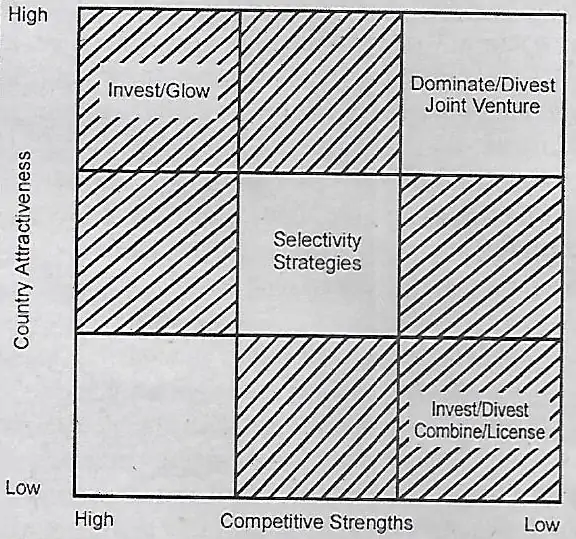Steps Involved in the Process of International Market Selection.
List of various steps involved in the process of international market selection are:
- Defining the market.
- Market segmentation.
- Determining the markets to be held.
Defining the Market.
Generally an international marketer faces heterogeneous foreign markets. Consequently, international marketer will have to define the market. Market definition is usually one dimensional i.e., a company can define the market in terms of country characteristics or in terms of product characteristics. Such a definition must also include a time frame and a reference to competition. The time frame is essential not only from the point of performance measurement and control but also for giving direction.
Thus, a short-term market definition would involve a tactical concern. Similarly, defining the competition would help in knowing precisely how the market is not being served, thus, it would pave way for the company’s positioning. Since market definition precedes segmentation it becomes necessary for it to be specific.,
Market definition must encompass both served the unserved markets. All this makes it necessary for a company to undertake the mechanical exercise of market definition.
Market Segmentation.
The modem marketing is customer-oriented. All marketing activities resolve around the customer. In order to achieve the marketing objectives, it is very necessary to have a clear picture of the customers characteristics which are not alike.
All commodity markets are not homogeneous rather they are heterogeneous. Two consumers of the same commodity are never in conformity with each other as far as their nature, habits, taste or interests, income, age, mode of purchasing or other attitudes are concerned.
So, all consumers wants cannot be satisfied with the same product. In order to facilitate the marketing of his product, the marketing manager, sub-divides a market into homogeneous sub-sets of customers having common customers in one set so that the customers may be served better with a distinct marketing mix. Such selection of sub-sets as a homogeneous group is called market segmentation.
Such markets can be segmented on the basis of characteristics of customers such as age, income, sex, religion, etc. or on the basis of geographical area such as urban or rural markets, national, international or local markets, etc. or on the basis of psycho-graphic or personality factors or on the basis of consumers behaviour. Different marketing strategies are followed in different market segments so that the organization can serve masses better.
Determining the Market to be held.
The next step in the process is usually to know which market to build, which to divest and which to abandon in order to optimize their return on investment. In other words they must define the direction of growth. For this purpose most companies use the country attractiveness/ competitive strength matrix as shown in Figure below.

Such a matrix helps in identifying invest/grow countries against Harvest/Divest countries. However, before using such a matrix the company must ensure that:
- Contributing factors are identified.
- Their relationship and direction have been established.
- Weights have been allotted to such factors.
It must also realize that such an analysis does not take into account:
- The risk of international operation.
- Cost of entry into various countries and markets.
- Shared costs in international marketing.
Keeping these facts in mind it becomes simple for a company to identify the market on the basis of growth. The various countries that can be identified on such a matrix would fall under any one of the following heads.
Invest/grow countries:
Such countries call for a high level marketing commitment. They represent a large market size which can be tapped through investment in people and capital. Here, it becomes necessary to match the products with the marketing requirements.
Harvest/ divest/ license/ combine countries:
There may be some countries which are not attractive today in terms of present potential of international marketing due to lesser competitive strength but have good potential. Such countries need to be harvested. A growth of market share in such a country would require an equal increase in marketing efforts. There may not be any gains in the beginning. Therefore, in such countries it makes more sense to sell out, to maintain a close watch of cash flow and to minimize the investment.
Dominant/Divest Countries:
There may be some countries which are highly attractive but have low competitive strengths. An international marketer have two alternatives to trade in such markets:
- To sell out.
- To develop competitive strength to reap the opportunities offered by such a market.
To reach such benefits on international marketer must analyze the market more closely in terms of cash required to build the strength and the potential profits. Time frame and corporate profitability are important issues in such a decision.
Selectivity Countries:
Such countries fall in the center of the matrix representing the fact that they are neither highly attractive countries nor highly unattractive. They also represent in company terms, a position that can be built or broken. In such situation the company can either unite the market or build the marked by introducing new product features, through technological up-gradations.
Such an analysis helps a company competing in the global scene to use its limited resources more effectively. It knows which markets to divest and which to hold. Even within markets it answers questions regarding which segments to build. In the absence of such an analysis the corporate profitability would fall because of inclusion of losers in the market portfolio and the company’s survival itself may come into question.



